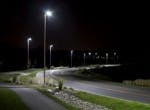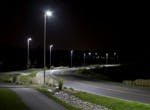The program has a demonstrated history of transforming the market and upgrading the quality, reliability, and energy-efficiency of lighting products by providing objective, third-party information to verify product performance compared to manufacturer claims.
As is the case with all NLPIP publications, Specifier Reports: Streetlights for Collector Roads was designed to tell a story in an objective way. The report was widely publicized [see links to LEDs Magazine articles under Related Stories at right], but many third-party summaries and interpretations were misleading, so hopefully this article will clarify a few key points.
Process
To emulate the streetlight selection process used by typical specifiers, NLPIP purchased and analyzed eight LED streetlights that were recommended by manufacturer representatives as equivalent to an incumbent technology, namely a 150W HPS streetlight with a Type III distribution.
Much to NLPIP’s surprise, all six of the LED manufacturer representatives recommended streetlights with lower light output than the incumbent HPS technology. However, in order to most closely follow the typical specifier selection process, those were the street lights NLPIP purchased and evaluated.
NLPIP analyzed the pole spacing needed for the streetlights to meet a national roadway lighting standard for collector roads, ANSI/IESNA RP-8. NLPIP then compared the streetlights’ power demand and economic costs over a one-mile stretch of roadway.
Results
The report concluded that, on average, the recommended LED streetlights could use up to 10% less power, however, their life-cycle costs were higher. The LED street lights recommended by the manufacturer representatives would cost more than twice as much to own and operate as the incumbent technology over the life of the streetlights, primarily because the LED street lights required narrower pole spacings to meet the recommended practice for illuminating collector roads, and the cost of the poles per mile dominated the life cycle costs.
A recent addendum to the original report examined LED street lights that could match the pole spacing provided by incumbent 150W HPS street lights. The results of the life cycle cost analyses are summarized in the chart below.
| Estimated life | Average life cycle cost per mile of recommended LED streetlights | Average life cycle cost per mile (excluding poles) of the "higher power" LED street lights |
|---|---|---|
| 25,000 hours (6 years) | 2.6X incumbent 150W HPS | 2.3X incumbent 150W HPS |
| 50,000 hours (12 years) | 2.1X incumbent 150W HPS | 1.7X incumbent 150W HPS |
The results of these analyses reinforce the fact that specifiers need to evaluate all available products, regardless of the technology, to provide their customers, as well as society, with the greatest lighting value.
In many ways the LRC is grateful for the attention given to this report, because the overarching goal of NLPIP is to provide objective information to those specifiers. Without that attention, many specifiers would have remained unaware of these findings.
Results Summary
To meet the collector-road lighting criteria, NLPIP found that when compared to HPS, current LED street lights:
• can save a modest amount of energy, and
• usually have a greater life cycle cost, with or without the need for new poles
Also, be aware that manufacturer representatives may recommend street lights that are not equal in performance.






